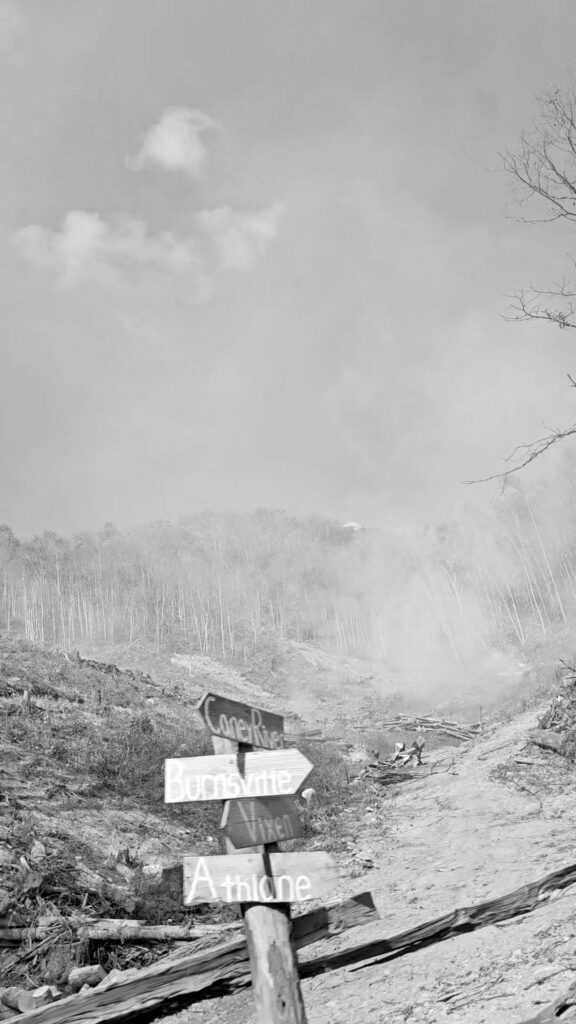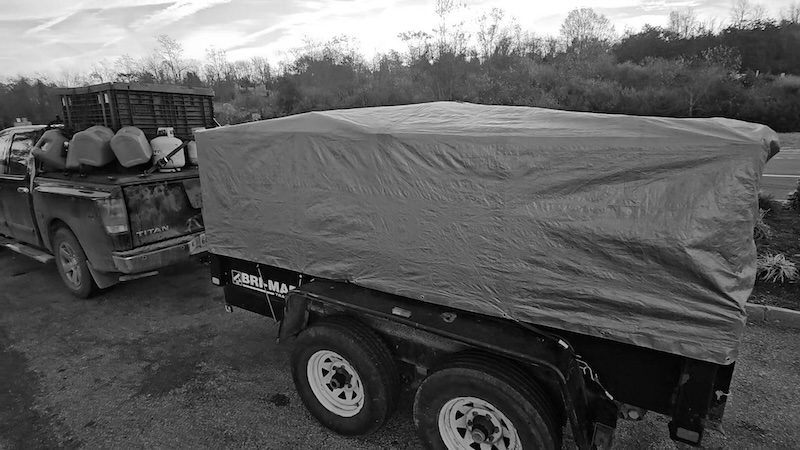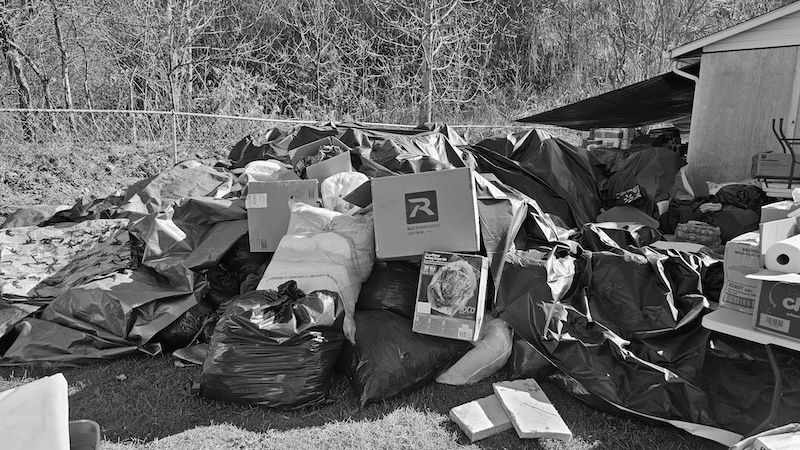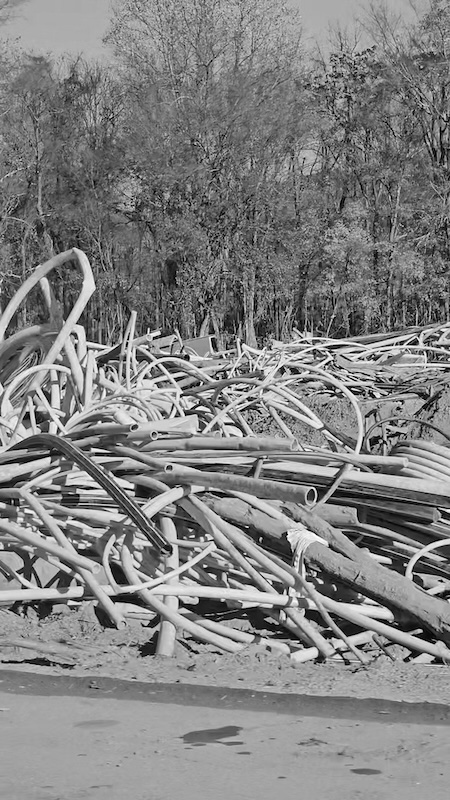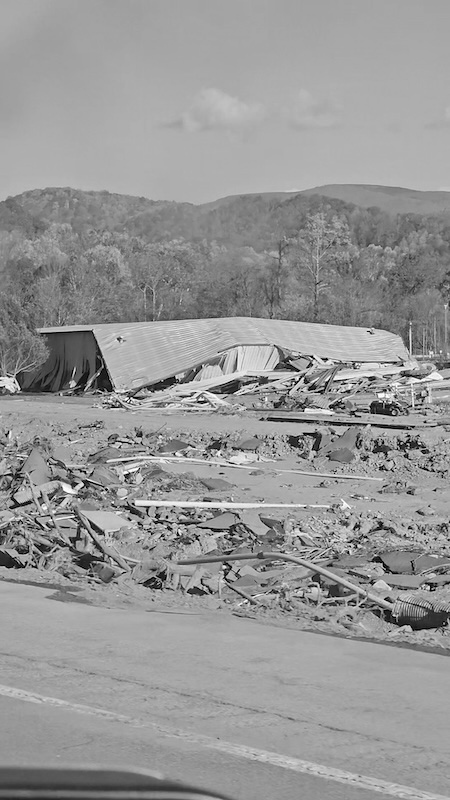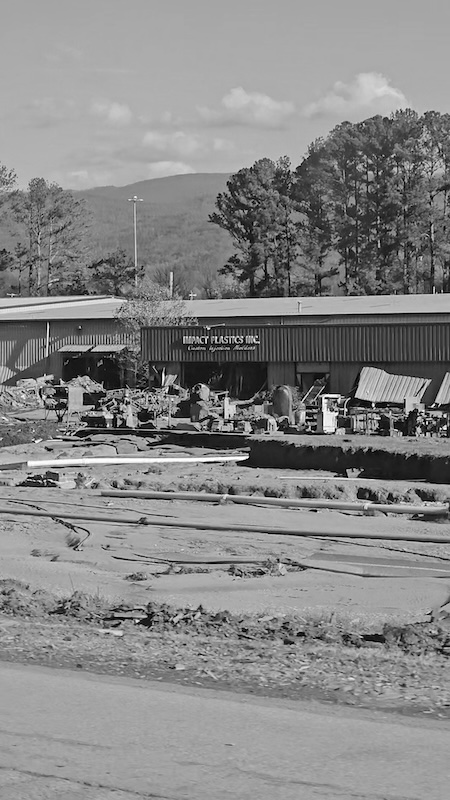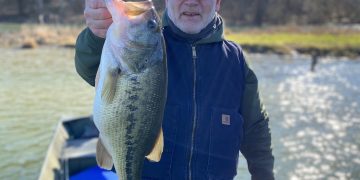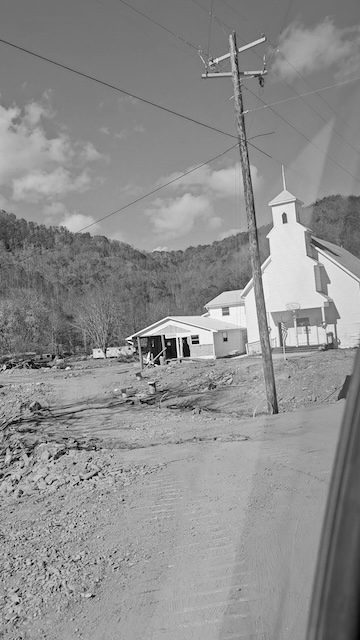
On Friday evening, September 27th, 2024, you would have found me in Ohio competing in a forging competition at the largest blacksmithing gathering in the country. It was raining buckets, but we had a pavilion and still had an enjoyable time despite the storm. Little did we know that while we were celebrating our craft, one of our own people, fellow blacksmith and mentor George Dixon, would lose his life trying to escape his home in rural Appalachia near Swannanoa. George’s story is one of thousands of tragic, heart-wrenching stories of the people of Western North Carolina. As soon as I heard the news of what happened, I was struck with a sense of responsibility as a fellow American to do something to help. I’m sure that many of you also heard that call to help.
Within a week after the hurricane, my brother Josiah had the opportunity to take a load of generators down to donate to the cause. After he arrived, he teamed up with a nonprofit group and assisted them in medical runs, debris cleanup, and K9 search and rescue. As much as I wanted to be there on the ground, I have responsibilities at home and could not go. My depression and the feeling of uselessness grew as I watched videos of the devastation and suffering on my cell phone. I told my wife that I wanted to help in some way, in any way that I was able.
During the following weeks, a local friend of mine with a large community following decided to donate her camper and asked if others would do the same. I keenly watched and listened to her success in rallying local community support in my town. Within a week, she was able to gather at least three campers, and the front porch of her farmhouse began to fill with donations of heaters, chainsaws, clothing, and more that neighbors felt inclined to give. Leslie was able to connect with a local Baptist church in a remote holler just outside of Burnsville, NC. They said they would be glad to receive the donations. Realizing that she was unable to travel herself, she put out a call for someone to drive a camper or at least take the donations. Without hesitation, I seized this opportunity to help and offered to take a load down. At this point, my compulsion to help had welled up so greatly that I needed to do something.
Wanting to have my own original contribution, I decided to help ease the issue of charging cell phones during the power outage and put out a call on social media for donations of cell phone backup batteries and solar panels. This call for help prompted many of those in my circle of influence to drop-ship these items, as well as monetary donations to support the call. I was tearfully joyful at how much I would be able to give. Working with Leslie and my brother, we were able to pack a pickup truck and a large dump trailer full of donations to take down. We had a list of specific requests from the Burnsville contact, which we filled, but we also added many other items to the load.
On Saturday morning, November 2nd, Josiah and I left at 6 a.m. for the 6-hour drive to Burnsville. Thoughts were racing through my head, both about how much hurricane damage I would witness and how we would be received when we got there. I envisioned being embraced by excited local families and being able to hand out much-needed aid. What I experienced was something much different. My expectations of the damage were met, even surpassed. But my expectations about the reception were challenged. In many ways, my emotional high was completely deflated.
Upon arriving in Burnsville, the hurricane flooding damage was evident in pockets of the town, but the main town was largely untouched. It wasn’t until we drove 10 miles outside of town, up into the mountains, that the gravity of the situation really sank in. Many roads were closed due to repair, and we had to follow handwritten instructions from our contact to find the little community and the little white church where we would meet. On the way, I saw long stretches of asphalt roads that had been washed away, just recently patched with gravel. Many homes along the road were uninhabitable as they’d been filled with mud. Vehicles of all types littered the creek bed or were wrapped around trees. Mudslides consisting of mature trees and boulders the size of minivans had sloughed off the side of the mountains, splintering any structure in their path. I saw single-wide trailers impaled through one side and out the other by trees. The power company was working to replace poles and string new wire. Phone and power wires were wrapped around trees and covered in mud. This spaghetti-like mess strung endlessly along the sides of the road. Anywhere the water flowed, the topsoil was gone, leaving entire properties stripped to the bedrock. The landscape has been permanently altered, never to be the same again. In one area, smoke hung low in the air as large piles of debris were being burned. Farmers kept the fires fed with tractors, skid loaders, and excavators. There seemed to be a growing issue with dust getting blown about, as the soil was no longer covered by vegetation, and the sandy red soil was left uncovered. The selective nature of the power of this storm was surreal. On one hillside were the most beautiful mature Appalachian poplar trees, steeped in fall colors. And right beside it was damage that one would expect to see after being pummeled by artillery fire from a military campaign. This 10-mile trek into the mountains was both awe-inspiring and terrifying. Finally, we reached the little white church, which served as the triage point for this remote community. The church had been flooded, but structurally it appeared to have survived. They had framed in and temporarily enclosed an outdoor pavilion, which they’d turned into a food pantry and a place from which to cook meals. Mobile laundry trailers had been set up, as well as porta-johns and mobile shower units. Spreading out from this hub in every direction were people living out of campers and tents, mostly tents.
The first thing I noticed upon arrival was how much of a hurry all the workers were in. Rush, rush, rush, so much to do. Everyone was clearly exhausted, both physically and emotionally. We were directed to an empty 53-foot semi-trailer that had been hauled in the day before to be used for storing more donations. Storage of donations and supplies was clearly an issue. Our contact, her husband, and another woman began hurriedly unloading our donations onto pallets and rolling them to the rear of the trailer. They were in a hurry. At this point, I began to feel like something was a bit off. The vibes I received were not at all what I was expecting. They didn’t really seem too excited that they had to interrupt their work to receive the offerings. The items that had been explicitly requested were set aside for pre-designated recipients, but about 75% of our load was being packed away. I could clearly see frustration on their faces when we unloaded clothing. It was new clothing: jackets, socks, thermals. They didn’t seem to be very excited. What was wrong, I asked myself.
Seizing a small window of silence, I pulled aside our contact’s husband, a state police officer, and asked him what was going on. How long would these donations be in storage? Did he think they would be useful to the community? Why did they seem frustrated? The first thing he explained to me was that this area was an honest and proud community. People didn’t feel right about asking for help or receiving handouts, even if they needed it. He told me of an elderly man who was still living out of his flooded-out house, who had just that week come into town. All he wanted was a sleeping bag but refused to take anything else because other people might need it more. There is a cultural and human reluctance to ask for or receive help, and it was particularly manifested in this little country holler. He informed me that they would store the items until people got desperate enough to ask for help, and when they did, they would let them pick out what they needed.
When we were ready to leave, we asked if there was anything else they could use our help with. I was expecting them to give us a revised list of donations. Instead, what they asked for was that we use our trailer to haul away a load of clothing donations that was in their way. We were directed to a pile of clothing in bags that could have filled a large dump truck. They asked if there was any way we could haul it back to Virginia and find other homes for it. This pile of clothes, though well-intended, had come with the burden of stewardship. I realized then that these people, having enough work as it was, were faced with additional work trying to manage all of the unrequested donations that had been sent there. We gladly obliged. We backed up our trailer to the pile. The church folks who had gathered for lunch formed a line of at least 20 people and, hand over hand, filled our little trailer within about 10 minutes. Afterwards, the pile looked untouched. “When can you come back for more?” one person asked.
In retrospect, I have some takeaways from this brief experience. I must remind you that my thoughts are based on one long day’s adventure to one isolated pocket of people. My experience is my own but may not represent the experience of all.
First, the way we think people need to be helped may not be the help that they really need. If we provide our idea of help, we may actually be creating more work for someone and hindering them. It is important in these situations to establish good communication with those on the ground and get a list of
specific needs before making assumptions. Although I use clothing as a primary example of this, there were many other items that were sent down, which will most likely go unutilized. At least it may take a long time for them to be redistributed to those who can use them. These items waste precious space in transport, cost money to store, and require untold hours of logistics and manpower to shuffle about.
Second, not every culture in America is the same. Some people, though they need help desperately, may not be willing to ask for it. Some people like to be left alone and take care of their own. I’m not saying that this community was entirely that way, but I certainly picked up on elements of it. I suspect they have grown weary of stopping in the middle of their recovery work to unload yet another delivery of unrequested donations, only to have to figure out where to put them. They are likely jaded by social media influencers and YouTubers seeking to expand their following by posting videos and pictures for their own selfish agenda. They are likely wary of looters, opportunists, grifters, and disaster tourists. This is a lot of extra stimulation for people to process all while they are reeling from the loss of family, friends, and neighbors. With all of these factors in place, their trust is most likely heavily guarded. While I was there, I was careful not to exploit their loss by taking pictures of any people to share, because I wasn’t asked to.
Third, I was asked on Facebook when I got back if I saw any presence of authorities. I’ve also received private messages expressing concern over what I might share. People are concerned that my experiences will either help or hurt a political narrative. I find this alarming. I’m not here to share political opinions, just what I observed. I have been asking myself, who are the authorities? The authorities are the residents of Burnsville, NC. It’s their town. They are the authorities. So yes! I saw the authorities. Local excavation companies, contractors, and farmers were running continuously up and down the roads in pickup trucks or on ATVs going about their business of cleaning up the mess. Filling in the gaps were Samaritan’s Purse and other non-profits. I did see a convoy of what looked like the state National Guard driving through town. I got the impression that they were there so that their presence would help to deter looters or people with ill intent. But I can’t speak to what they were doing directly because I don’t know. I saw one pickup truck marked American Red Cross. I saw many pop-up donation centers set up by locals and volunteer groups. No, I did not see FEMA, but that doesn’t mean they weren’t there. They could have been. What was clear to me was that the community was taking care of their own. I saw what will take many years of work to clean up.
Going forward, I’m left with the question I started with: how can I help? I received many monetary donations that need to be utilized in some way. My brother and I have decided that moving forward, we will put our efforts into obtaining campers and connecting them with families who are actually requesting them. Another local friend has established contact with a school principal who has names of displaced families with children who are requesting housing. We are making sure that the need and desire for this housing are thoroughly vetted. We currently have two to three campers in the works to be transported and are intending to use any more funds to purchase another or repair the current ones. As this mission develops, we will definitely be in need of funding to carry this out. We are working to make contact with another organizer who allegedly has a waiting list of 77 families requesting housing. We feel that this is the best use of our efforts. As for our contact in Burnsville who received our donations, they have said that if they need any more donations, they will send us an itemized list. We are prepared to help with that if needed. Do I feel like our first trip was fruitful? Were our donations helpful? The answer is absolutely yes! But I learned a lot that will help us moving forward.
Thank you to any of you who have helped with this effort. It is not wasted. However, it is important to heed these lessons, to listen to the actual needs, and to use wisdom moving forward.
